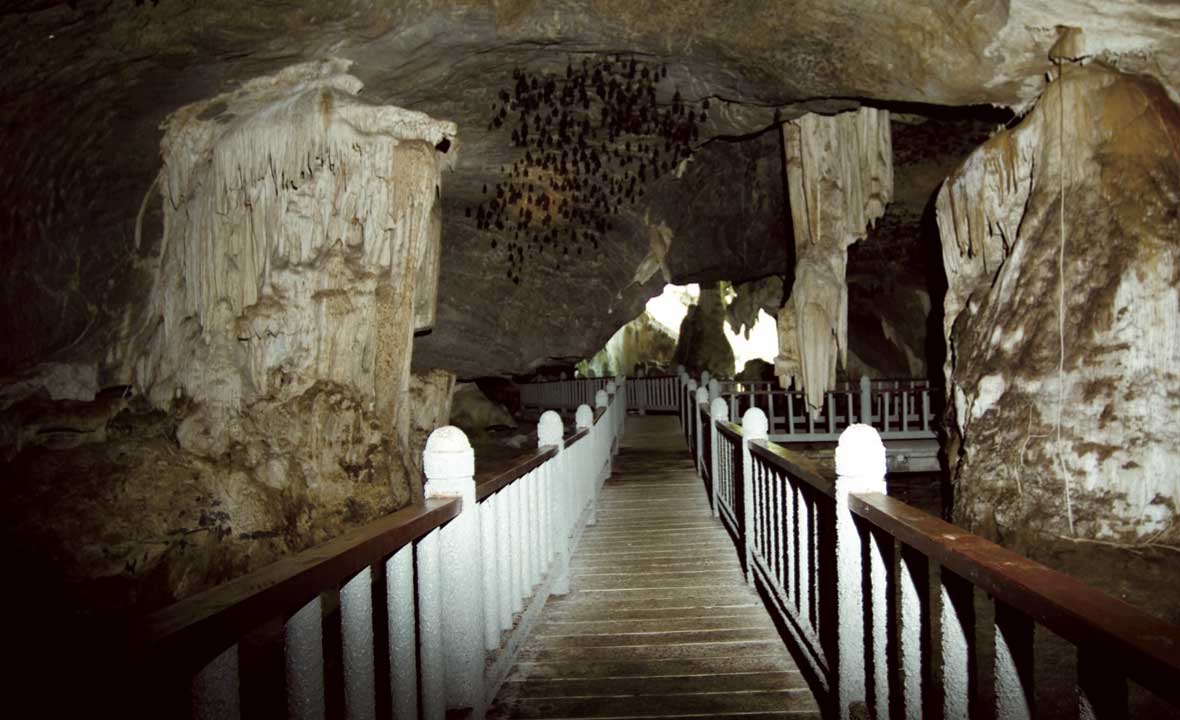CAVE EXPLORATION
Caving or spelunking enjoys a good following in Malaysia. The country is endowed with vast numbers of limestone caves, including a World Heritage Site. They are home to amazing wildlife such as fruit bats, birds with edible nests or attractive stalagmites and stalactites.
Many are surrounded in mystery and legends. Archaeological research has found evidence of early man in many of these cave sites.
Although major expeditions have been carried, many caves are still not fully explored and remain an alluring adventure for the nature explorer. Repeat visitors marvel at how a cave can change within months as the naturally wet Malaysian weather promotes faster stalagmite and stalactite formation.
Caves come in various levels of accessibility. Some caves even have walkways to ease your touring, while others require visitors to rough it out and crawl on all fours.
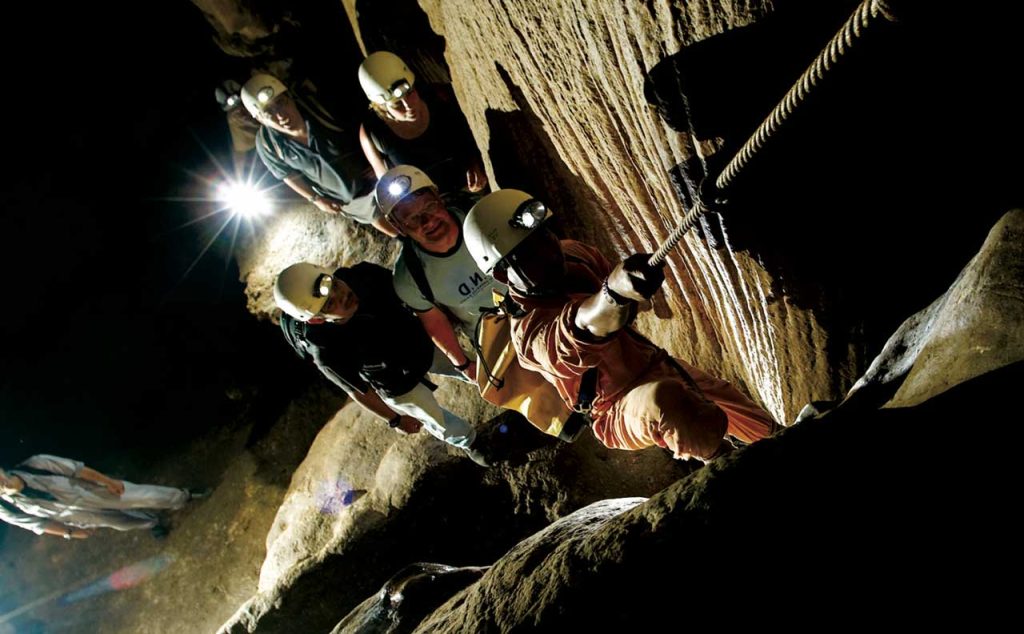
CAVES OF MALAYSIA
In the Malay language, cave is ‘gua’, with the majority being limestone and are above ground level. In the peninsula, the list features Gua Kelam in Perlis, Gua Tempurung and Kundu in Perak, scattered historic caves around Lake Kenyir in Terengganu and Gua Ikan in Kuala Krai, Kelantan. Famous caves in Sarawak include Niah and Mulu as well as Fairy Cave at Bau. Gua Gomantong, where bird’s nests are collected, is the most well known cave in Sabah
Underwater or river caves can be found in the Kinta Valley, making up less than ten per cent of local caves – and are to be avoided during rainy periods. There are also dolomite and sandstone caves scattered around the country.
Caves can be divided into two categories: adventure and show caves. Adventure caves such as Drunken Forest Cave and Legan’s Cave in Gunung Api, Sarawak remain close to their natural state. Show caves such as Deer, Lang and Clear Water Caves in Mulu National Park are those that are equiped for public visit, with lights as well as clearly marked paths and

CAVE ATTRACTIONS
Malaysian caves are home to many exotic creatures. Notable are the blind catfish of Loagan’s Cave and the Trapdoor Spider of Batu Caves.
LIST OF MALAYSIAN CAVES
- Gua Kelam, Perlis
- Gua Wang Burma, Perlis
- Gua Gunung Keriang, Kedah
- Gua Kelawar – Kilim Mangrove, Langkawi,
- Gua Tempurung, Kampar, Perak
- Gua Kundu, Gopeng, Perak
- Dark Cave, Batu Caves, Selangor
- Gua Batu Maloi, Tampin, Negeri Sembilan
- Gua Ikan, Kuala Krai, Kelantan
- Gua Taat and Gua Bewah at Tasik Kenyir, Terengganu
- Gua Telinga, Gua Daun Menari, Gua Luas and Gua Kepayang, Taman Negara, Pahang
- Gua Kota Gelanggi, Jerantut, Pahang
- Gua Charas, Kuantan, Pahang
- Gua Padang Kawat, Gua Rimau, Gua Panjang, Gua Kubang Rusa, Gua Gunting, Gua Goyang dan Gua Pasir Besar, Merapoh, Pahang
- Gua Harimau, Gua Hijau, Gua Buta, Taman Eko Rimba Kenong, Kuala Lipis, Pahang
- Fairy Cave, Wind Cave and Jambusan Cave, Bau, Sarawak
- Great Cave and Painted Cave, Niah National Park, Sarawak
- Sarawak Chamber, Deer Cave, Green Cave, Clear Water Cave, Moon Cave and Turtle Cave, Mulu National Park, Sarawak
- Gua Madai, Lahad Datu, Sabah
- Gua Gomantong, Sandakan, Sabah
- Gua Padang Kawad, Gua Rimau, Gua Panjang, Gua Kubang Rusa, Gua Gunting, Gua Goyang, Gua Pasir Besar dan Gua Hari Malaysia, Merapoh, Pahang
- Gua Kolam Tujuh, Gua Angin, Gua Terang Bulan, Gua Taman Satu, Gua Taman Dua, Gua Gajah, Gua Makam Tok Long dan Gua Silat, Gunung Senyum, Temerloh, Pahang
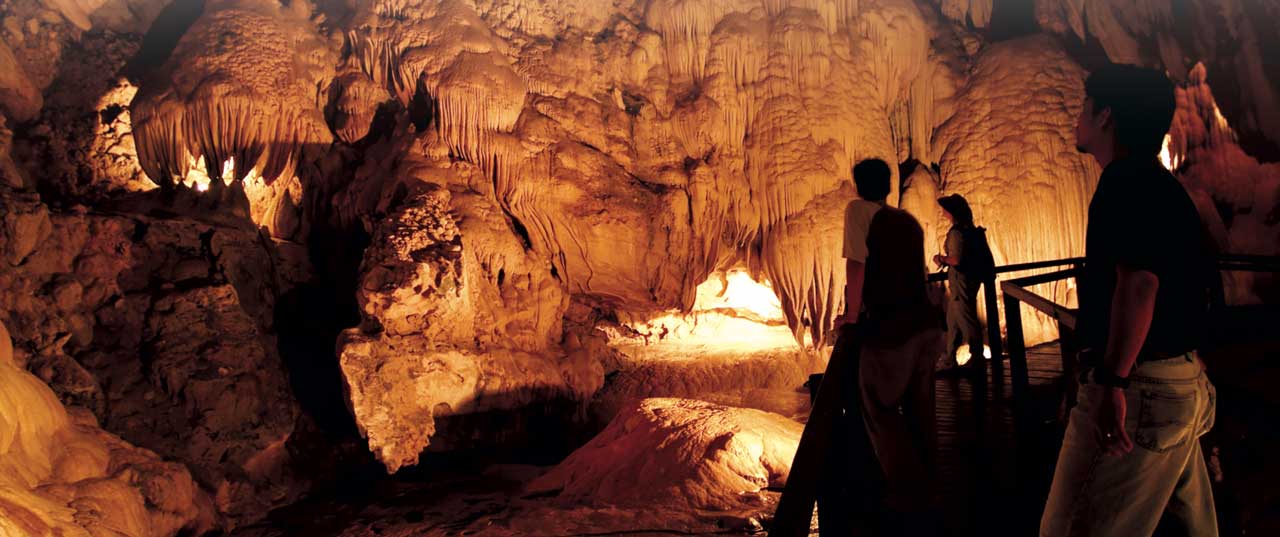
Gua Gomantong near Sandakan, Sabah, houses thousands of swifts in the two large caverns, which produce birds’ nests, an exotic Chinese delicacy.
The skeleton of a big cat fossilised in the roof of Gua Harimau in Kinta Valley makes an intriguing sight. Perak is also famous for its cave temples, the most well known are Perak Tong and Sam Poh Tong, which contain many Buddha statues and religious cave murals. The Hindu cave temple in Batu Caves have shrines to the Hindu deities and is the site for the colourful religious festival of Thaipusam.
The Painted Cave in Gua Niah in Sarawak has walls displaying unique prehistoric paintings including boats that point to early man’s local civilisation. Its chambers have hundreds of fascinating formations.
The Mulu Caves in Sarawak has some of the biggest and longest networks of caves in the world. Although 195 kilometres of cave passages have already been surveyed, these represent just 30% of the estimated total. Here the Sarawak Chamber, 600m by 415m and 80m high, is the largest known cave chamber in the world. The Deer Cave measuring 120 to 150m in diameter is the world’s largest cave passage and at 108km, Clearwater Cave is the longest cave in Asia. An estimated four million bats live in this cave system.
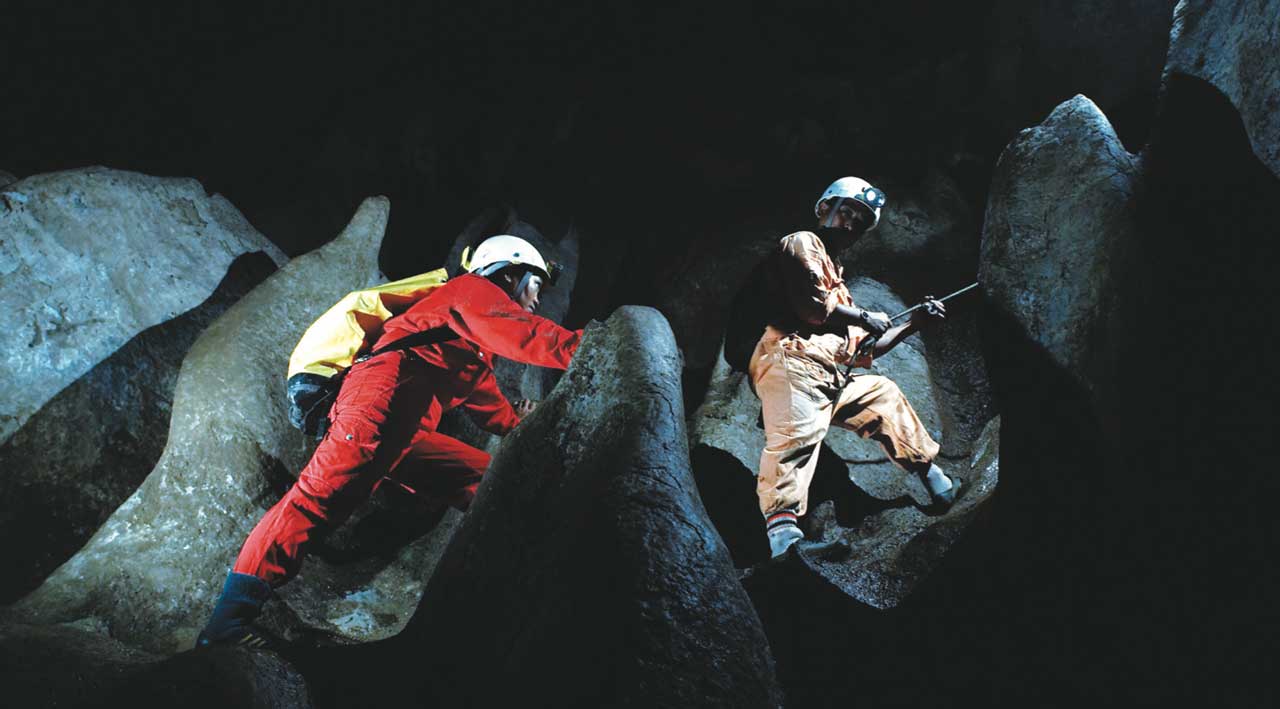
GOING CAVING
There are seasoned cavers who will be willing to act as guides. They may be contacted through the Malaysian Nature Society and adventure clubs or operators.
Most caving expeditions are day trips although a visitor can choose to stay overnight. No overnight camping is allowed within most caves but room accommodation is usually available around most cave districts.
Caving is normally done in the relatively dry season from March to October, but be prepared for rain anytime. Permits may be required when exploring some caves. These are available from the respective state forestry departments and cost from RM10 to RM40.
Tropical caves are not as damp as those in Europe and the Americas but they are chilly at times especially during storms and heavy rain. A light jacket is recommended.
As with all nature adventures, conservation of stalagmites, stalactites and all cave wildlife are of utmost importance. In caves with known inhabitants, avoid flash photography as the light frightens the cave-dwelling life forms.
Note the possibility of encountering potentially dangerous creatures around caves such as snakes or scorpions.
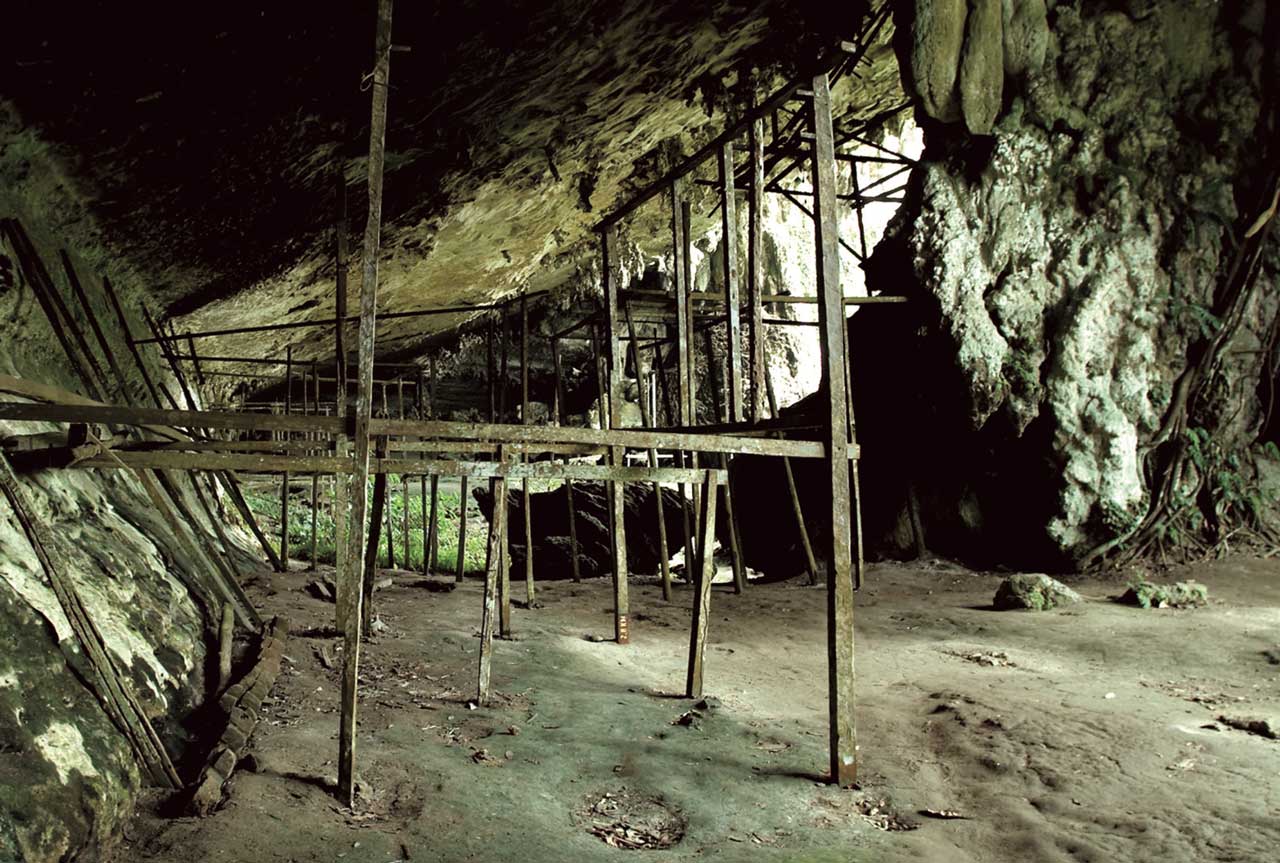
CAVING – PRACTICAL TIPS
- Always take a reliable guide, who can be hired from the national parks or from caving clubs. Many of Malaysia’s caves are unmapped and not even an experienced caver should go exploring alone. Groups of four are optimum.
- Although some operators offer cave diving, it is a highly specialised sport and should only be undertaken by professional divers and cavers.
- Always check equipment before venturing into a cave especially when abseiling.
- Experienced cavers recommend a maximum of eight hours in a cave at a stretch but most caves take less than three hours to explore.
- Plan how much lighting you will need. One kilogramme of carbide will give enough illumination for approximately six to eight hours.
- Cavers should always carry back-up torches and extra batteries.
- Heart patients and those suffering from claustrophobia should limit themselves to show caves where guides take in groups of 20 to 40 people. Cavers should be free from allergies related to limestone and bat guano.
